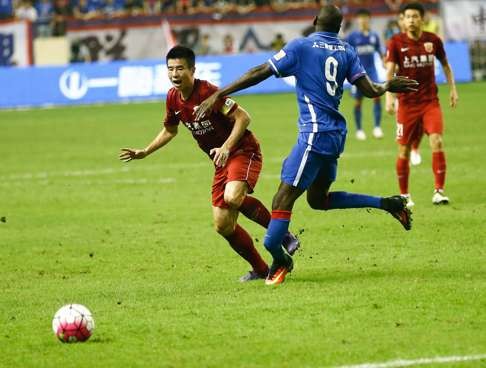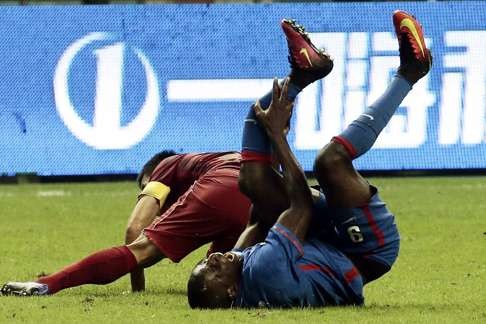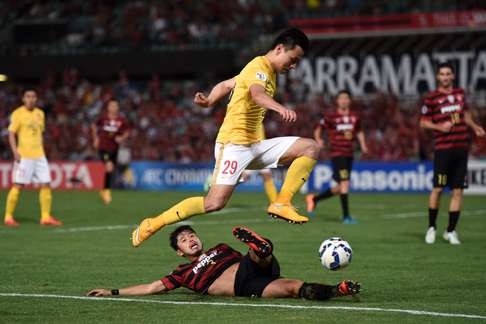Why the Shanghai derby has become one of China football’s most heated rivalries
Weekend’s game – marred by horrific injury to Demba Ba – was another impassioned battle for local bragging rights

Shanghai Greenland Shenhua versus Shanghai SIPG doesn’t exactly slip off the tongue, but while the names might not be in the traditions of the world’s great football clubs, the rivalry is close to any. Some have even begun to whisper that it is the biggest derby in Asia.
In truth, that’s a stretch. And something that the fans of Tehran rivals Esteghal FC and Persepolis – a derby that dates back to the late 1960s, involves the two most successful teams in Iran and has seen crowds of up to 120,000 in the stands – would take issue with.
Yet while the Shanghai derby lags behind those numbers but it is already close in terms of the passions it elicits between the rival fans. Something that is all the more remarkable considering that the clubs first met in the league in the 2013 CSL season.
That was the newly renamed Shanghai SIPG’s debut campaign, the club having changed its name from Shanghai East Asia after investment from the Shanghai International Port Group, but the clubs already had a history going back nearly two decades.
WATCH: highlights of the Shanghai derby
The clubs’ original link – Shanghai East Asia founder Xu Genbao managed Shenhua to the Chinese league title in 1995 before starting his own football academy – has since gone, following SIPG’s full takeover of the club but that has done nothing to calm passions.
In fact, things have only intensified. Despite the fact that Shenhua also received investment, in the form of sponsor Greenland, SIPG are seen as both moneyed and Johhny-Come-Latelys by their city rivals – think of all the worst things thrown at Manchester United and Chelsea over the years. Something not helped by SIPG’s meteoric rise to being one of the strongest teams in the CSL, a place once held by Shenhua.

For the Shenhua fans this manifests as ammunition for social media ridicule and the accusation that SIPG are not the city’s true club. Shenhua fans infiltrating SIPG’s Champions League away games this season with “Only Shenhua rep Shanghai” banners is a prime example of how much rivalry this means.
Like all good derbies, the game has also delivered on the pitch despite its brief history. Last season at Shanghai Stadium, SIPG beat the eight-man visitors 5-0. There was even time for a spot of highjinks in the dugouts when former Tottenham Hotspur and England keeper Ian Walker – who was goalkeeping coach at Shanghai Shenhua before taking up the role across town – inadvertently floored Tim Cahill’s translator with a friendly slap.
WATCH: Demba Ba suffers horrific leg break (warning - graphic)
This weekend the Shanghai derby once again lived up to its billing. Strong feelings were on full show at Shenhua’s Hongkou Stadium on Sunday night where the SIPG bus was pelted with rubbish by the home fans and the atmosphere was electric.
Those watching at home could have been forgiven for thinking it was the Merseyside derby with teams in red and blue battling it out and battle was the key word. There were two red cards and several yellows, and the game was only decided in the eighth minute of injury time by a Shenhua penalty.
Bragging rights went to the Blue Devils with a 2-1 victory but SIPG are now legitimately in the AFC Champions League places (because their closest rivals have floundered over recent weeks), have Hulk and Dario Conca to return from injury, and they have not lost the league’s topscorer to a broken leg – Shenhua’s star man Demba Ba was stretchered off and is surely out for the season.

Shanghai might play host to the only true city derby in the CSL, both teams started out in the city rather than moving in after forming elsewhere –something that continues to happen in Chinese football. But that doesn’t mean it is China’s only rivalry. It’s not even the only rivalry in Shanghai.
Shanghai Shenxin are also in the mix. Both SIPG and to a lesser extent Shenhua consider them rivals, although Shenxin’s freefall after being relegated from the CSL last season – they are currently in a relegation scrap in China League One – means it may be a while before those league derbies resume.
Shenhua’s other main rivalry is less of a traditional derby and more in the vein of Spain’s El Clasico or Liverpool against Manchester United, where the country’s strongest teams continue a hatred that exists for other reasons.
China’s largest city and its capital have long had a strong rivalry and it has manifested in football terms between Shenhua and Beijing Guoan, with a fierce enmity both on and off the pitch despite the 1,200 kilometres between the teams.
The Beijing side also play out hostile matches against neighbours Tianjin TEDA, who are their closest local rivals but the cities are technically 140km apart, even if the expansion of both means they may soon become amalgamated into a supercity.
Next season TEDA might have a traditional city derby should Fabio Cannavaro’s Tianjin Quanjian can keep on course for promotion. What that derby becomes remains to be seen, though. Quanjian started playing their football in Hohhot, Inner Mongolia, before moving to Tianjin, the homebase of their original owners.
That means it could be like the current Guangzhou derby. Evergrande and R&F share a city but R&F only arrived there from Shenyang via Changsha in Hunan province, and Shenzhen in 2011.
Much like the Hebei derby between Hebei China Fortune FC and Shijiazhuang Everbright, there is no rivalry between the Guangzhou clubs. In fact, Evergrande’s biggest rivalry since gaining promotion to and subsequently dominating the CSL has not been in China at all but in the AFC Champions League.

Their ties with Western Sydney Wanderers have resulted in brawls, red cards and managers running on the pitch. They have also involved plenty of goals and the last two winners of the AFC Champions League.
Guangzhou had the last laugh, though, as they took the crown from the defending champions, having qualified at their expense in the group stage.
As ugly as brawls, pelted buses and sendings off are, they are a part of the rivalry that makes football the game we all love. The fact that Chinese football has already developed that despite long distances, constant relocation and short histories– both within the CSL and on the continental stage – can be only a good thing for the future.